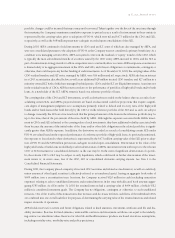American Express 2003 Annual Report Download - page 61
Download and view the complete annual report
Please find page 61 of the 2003 American Express annual report below. You can navigate through the pages in the report by either clicking on the pages listed below, or by using the keyword search tool below to find specific information within the annual report.
(p.59_axp_ financial review)
The Company believes that the securitized financing would be available even through adverse conditions due to the struc-
ture, size and relative stability of the securitization market. Proceeds from secured financings completed during a liquidity
crisis could be used to meet current obligations, to reduce or retire other contingent funding sources such as bank credit
lines, or a combination of the two. However, other factors affect the Company’s ability to securitize loans and receivables
and do so at a favorable cost to the Company, such as credit quality of the assets and the legal, accounting, regulatory and
tax environment for securitization transactions. Material changes in any of these factors may potentially limit the Company’s
ability to securitize its loans and receivables and could introduce certain risks to the Company’s ability to meet its financial
obligations. In such a case, the use of investment securities, asset dispositions, asset monetization strategies and flexibility
to reduce operating cash needs could be utilized to meet its liquidity needs.
Risk Management
For TRS’ charge card and fixed rate lending products, interest rate exposure is managed through a combination of shifting
the mix of funding toward fixed rate debt and through the use of derivative instruments, with an emphasis on interest rate
swaps, that effectively fix TRS’ interest expense for the length of the swap. The Company endeavors to lengthen the matu-
rity of interest rate hedges in periods of falling interest rates and to shorten their maturity in periods of rising interest rates.
For the majority of its cardmember loans, which are linked to a floating rate base and generally reprice each month, TRS
uses floating rate funding. TRS regularly reviews its strategy and may modify it. Non-trading interest rate products, pri-
marily interest rate swaps, with notional amounts of approximately $39 billion (a portion of which extends to 2011) were
outstanding at December 31, 2003.
The detrimental effect on TRS’ pretax earnings of a hypothetical 100 basis point increase in interest rates would be approx-
imately $64 million ($50 million related to the U.S. dollar) and $50 million ($40 million related to the U.S. dollar), based
on the 2003 and 2002 year-end positions, respectively. This effect is primarily a function of the extent of variable rate fund-
ing of charge card and fixed rate lending products, to the degree that interest rate exposure is not managed by derivative
financial instruments.
TRS’ foreign exchange risk arising from cross-currency charges and balance sheet exposures is managed primarily by enter-
ing into agreements to buy and sell currencies on a spot or forward basis. At December 31, 2003, foreign currency products
with total notional amounts of approximately $9.9 billion were outstanding.
Based on the year-end 2003 and 2002 foreign exchange positions, but excluding forward contracts managing the antici-
pated overseas operating results for the subsequent year, the effect on TRS’ earnings of a hypothetical 10 percent change in
the value of the U.S. dollar would be immaterial. With respect to forward contracts related to anticipated overseas operat-
ing results for the subsequent year, a 10 percent change would hypothetically impact pretax income by $57 million and $59
million related to the 2003 and 2002 year-end positions, respectively.
























